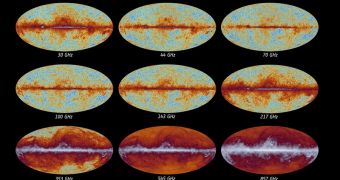When the European Space Agency (ESA) launched the Planck Telescope, the mission's main objective was to create a series of maps of the Cosmic Microwave Background, the relic radiation left behind by the Big Bang. A number of discrepancies between Planck data and theoretical models have now been explained.
The Planck telescope was such a precise instrument that even minor differences between its maps and theoretical models could imply that the models and computer simulations were wrong. When the results of the mission were first announced, in March 2012, numerous variations were discovered.
This left astronomers to ponder one of three possible explanations. First, telescope data may have been handled or interpreted improperly. Second, it could be that numerous studies previously conducted in space and on the ground arrived at the wrong conclusion. The third explanation was that the model explaining our Universe may be wrong.
During its all-sky survey in three radio bands, Planck found a lower value for the Hubble constant than predicted. This constant explains the speed at which the Universe expands. Additionally, Planck detected higher densities of matter in the early Cosmos than models allowed for.
In a new study, cosmologists David Spergel and Renée Hložek, from the Princeton University in New Jersey, and Raphael Flauger from the Institute for Advanced Study and the New York University suggest that the discrepancies may have originated in systematic Planck data errors.
“Planck is so precise that even small discrepancies become interesting,” says Spergel, who became intrigued by the telescope's findings as soon as they were published. His team was able to show in their new paper that the issue lies with Planck's sky map created at a frequency of 217 gigahertz.
If this particular map is removed from the dataset, then the telescope's findings come into alignment with theoretical predictions of how the early Universe should have looked like. Other sky maps were created at 100 and 143 gigahertz, respectively.
The team explains in a paper published on the arXiv preprint server that the 217 GHz map appears to have failed some initial calibration tests, which led to the telescope producing erroneous results. Additionally, the Planck team did not account for this issue in subsequent analyses of the date, Nature reports.
“There is an issue with one set of detectors on Planck, which we were aware of, but didn't properly understand by the time of the 2013 data release,” explains Planck science team member George Efstathiou, who is an astrophysicist at the University of Cambridge, in the UK.
“It is a small systematic and has very little impact on the cosmology, but it is a systematic that will be removed from the 2014 data,” the expert adds. “I anticipate that the Planck 2014 analysis will be an improvement on the Planck 2013 analysis,” Spergel concludes.

 14 DAY TRIAL //
14 DAY TRIAL //